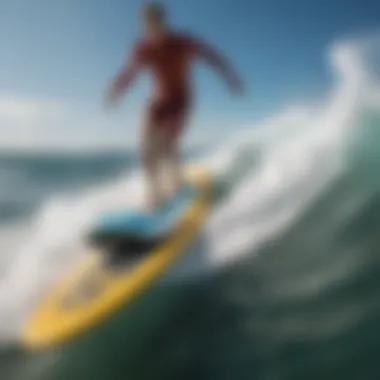Exploring Motorized Water Surfboards: A Comprehensive Guide


Intro
The world of surfing is evolving at a rapid pace, embracing the latest innovations in technology. Among these advancements, motorized water surfboards have garnered significant attention, offering a fresh perspective on how we interact with the waves. This guide seeks to illuminate the intricacies of these modern surfboards, exploring their design, functionality, and the impact they have on surfing culture.
Motorized water surfboards are not mere trends; they bring about new ways of riding water and open up possibilities beyond traditional surfing. As we delve deeper, we’ll uncover the various techniques that can enhance one’s experience while riding these boards. This exploration also includes a review of the cutting-edge equipment available, crucial for both novice and seasoned surfers alike. Furthermore, we will discuss the safety measures one must consider, ensuring that every ride is as thrilling as it is secure.
In the course of our narrative, we will also touch on essential environmental factors and highlight the modern surfing community's path towards being more eco-conscious. In a niche market that's still in its infancy, there is much to anticipate, making now the perfect moment to explore motorized surfboards and what they signify for the future of rideable waters.
Stay tuned as we navigate through techniques that can elevate your surfing game, discover must-have equipment, and emphasize how these developments shape not just the sport but the broader ocean landscape.
Preface to Motorized Water Surfboards
In recent years, motorized water surfboards have taken the surfing world by storm. These innovative machines have merged the thrill of surfing with the power of motorization, creating a fresh wave of excitement among water sports enthusiasts. This section serves as your entry point into understanding the critical aspects of motorized water surfboards, including what they are, their purpose, and their historical evolution.
Definition and Purpose
Motorized water surfboards, commonly known as electric surfboards, are essentially surfboards equipped with a battery-powered motor that propels the rider across the water’s surface. These boards enable users to zip across waves and flat water alike, allowing for a different riding experience entirely compared to traditional surfboarding.
The purpose of these boards isn’t just to offer speed; they serve to enhance accessibility to surfing for individuals who may not have the physical prowess to paddle out on their own. Moreover, they provide an opportunity for thrill-seekers to experience water sports without the need for ocean swells or even skillful paddling. Whether it’s riding leisurely or tackling gnarly waves, motorized surfboards provide a versatile platform tailored to a broad audience, from beginners to seasoned surfers.
Historical Context
The journey of motorized surfboards has its roots deeply embedded in the evolution of aquatic sports. The idea of motorized boards took off in the late 20th century, but initial prototypes did not catch on as they were bulky and inefficient. In the early 2000s, advancements in battery technology and lightweight materials began to breathe life into these machines. Companies like JetSurf began pioneering designs that offered improved functionalities paired with sleek aesthetics.
By the 2010s, motorized surfboards had cemented their place within the water sports realm. The designs became more user-friendly with better control systems, making them appealing to a broader range of users. With their rising popularity, motorized surfboards have made appearances in various surfing events and competitions, further solidifying their validity in surfing culture.
As motorized surfboarding continues to develop, discussions about regulations and the environmental impact arise, echoing the evolving relationship between technology and traditional water sports.
"The fusion of technology and tradition in surfing speaks volumes about our adaptability, ensuring that everyone can enjoy the freedom of riding the waves in some form."
Understanding the definition and historical context of motorized water surfboards provides a solid foundation for exploring the intricate technology, performance characteristics, and the community's perspectives on these exciting devices.
The Technology Behind Motorized Surfboards
Understanding the technology behind motorized surfboards is key to appreciating their value in modern water sports. These boards are not just a gimmick; they reflect a blend of innovation in engineering and a fresh take on traditional surfing. From their propulsion systems to the interface that riders interact with, every detail is crafted to enhance the experience on water. Knowing how these technologies work makes it easier for surfers to choose the right equipment that fits their needs, boosts performance, and aligns with safety protocols.
Engine Types and Specifications
When it comes to motorized surfboards, the engine type plays a vital role in determining performance characteristics. Motorized surfboards typically utilize two main types of engines: electric and gasoline-powered. Electric engines, like those found in boards from brands such as JetSurf, are becoming increasingly popular due to their environmental benefits and quieter operation.
Electric motors provide instantaneous torque, allowing for quick acceleration which many surfers cherish. They are also generally lighter, translating into more agile boards on the water. However, electric engines have limitations in terms of battery life, ranging anywhere from 30 minutes to a couple hours, depending on usage and conditions.
On the flip side, gasoline-powered engines often deliver longer runtimes and can attain higher speeds, making them desirable for thrill-seekers. But they come with trade-offs; more noise, increased weight, and the need for regular maintenance can be drawbacks for some users.
In terms of specifications, most engines are rated anywhere from 1.5 horsepower to 6 horsepower, with speeds reaching anywhere between 20 to 40 km/h. Choosing between these engines ultimately boils down to the rider's needs, preferences, and commitment to maintenance.
Battery and Power Management Systems
Electric motorized surfboards rely heavily on sophisticated battery and power management systems. These components ensure the board does not simply fizzle out mid-ride, leaving the surfer stranded. Lithium-ion batteries are the gold standard here, bringing high energy density, long life cycles, and relatively low weight compared to traditional batteries.
The power management system is a crucial element as it monitors performance. It controls how energy is used, optimizing rides based on the surfer's style and intensity. Many modern boards come equipped with displays or even mobile apps that provide real-time data on battery life and remaining ride time, allowing surfers to gauge whether to push their limits or conserve their power.
Proper battery care, like ensuring it’s fully charged before a session and monitoring temperature, plays an integral role in extending the lifespan of these systems. Moreover, advancements like fast-charging capabilities are popping up, helping surfers stay on the water with minimal downtime.
Control Systems and User Interfaces
The learning curve for a motorized surfboard can heavily depend on the control systems and user interfaces integrated into the design. Most motorized surfboards come with hand-held remotes, where the surfer can power the board up, accelerate, and reverse.
In recent years, we’ve seen the emergence of smart controls—including Bluetooth connectivity that allows for seamless interactions between the board and the user through a mobile app. These interfaces typically offer features such as:
- Speed Control: Riders can set desired maximum speeds.
- Profile Settings: Personalize settings for different water conditions.
- Safety Alerts: Notifications about battery status and impending issues.
Some users find the added tech appealing, while others may feel overwhelmed, so it's important for manufacturers to strike a balance between user-friendliness and the breadth of features. With a straightforward interface, surfers can focus on riding rather than fussing over gadgets.


"The combination of technology and surfing opens up a new frontier. Understanding these systems is crucial for both beginners and seasoned veterans as they navigate the evolving world of water sports."
This intricate dance of mechanics—engine types, battery systems, and user interfaces—illustrates that motorized surfboards are a significant advancement in surf technology. Each element works together to provide a thrilling yet navigable journey in today’s water landscapes.
Design Considerations in Motorized Surfboards
When it comes to motorized water surfboards, the design considerations play a pivotal role. From materials to shape, each element influences not just aesthetics, but performance as well. Designers must navigate various aspects to ensure durability, efficiency, and a thrilling experience for users. In this section, we will explore the critical factors that contribute to the overall effectiveness of these innovative boards.
Materials Used
The choice of materials in motorized surfboards is crucial, as they substantially impact ride quality, durability, and weight. Manufacturers often opt for lightweight materials like carbon fiber or fiberglass combined with a solid core of expandable foam. This combination ensures a robust construction without being too heavy to handle.
For instance, carbon fiber is favored for its high strength-to-weight ratio. Not only does it provide excellent rigidity, but it's also resistant to corrosion, making it suitable for saltwater conditions. Meanwhile, fiberglass offers a more affordable option, albeit with some trade-offs in terms of weight.
Additionally, the choice of material also considers environmental impact. Eco-friendly options, such as recycled plastics or bio-resins, are gradually gaining traction among manufacturers looking to appeal to eco-conscious surfers.
"The materials used in surfboards are a reflection of the surfer’s style and the performance they expect from their gear."
Shape and Dimensions
The physical contours of a motorized surfboard dictate how it performs on water. The board’s shape affects hydrodynamics, maneuverability, and speed. Most boards are designed with a sleek profile that reduces drag, allowing surfers to slice through water effortlessly.
Wider boards provide stability; hence, they are often recommended for beginners. Conversely, narrower boards enhance agility and speed, appealing to experienced riders looking for thrills.
The length also plays a significant role. A longer surfboard can maintain balance better, while shorter boards enable sharp turns and quick maneuvers, vital for more advanced surfing techniques. Customization in dimensions allows various users to find their sweet spot, ensuring performance tailored to their needs.
Weight Distribution and Balance
Weight distribution is another essential factor in the design of motorized surfboards. Irrespective of skill level, surfers rely on balance to maintain control while navigating the waves.
A well-designed motorized surfboard should have its weight distributed evenly for optimal stability. This often means placing the motor and battery in a way that centers the weight, preventing the board from tipping over during high-speed maneuvers or sudden stops.
Surfers exploring the waters need to be confident in their gear. Proper weight balance not only supports performance but significantly enhances safety, as it minimizes the risk of falling or losing control. Moreover, this aspect of design promotes a smoother experience when changing speeds – crucial for adjusting to different wave conditions.
In summary, the intricacies of design in motorized surfboards are not mere footnotes; they are foundational elements that shape the entire experience. With the right materials, shapes, and thoughtful balance, these boards can provide an exhilarating, yet safe, adventure on the water.
Performance of Motorized Water Surfboards
Performance is a critical aspect when it comes to motorized water surfboards. It's not just about speed; it encompasses the entire riding experience, from how easily you can turn to how well the board behaves on unpredictable waves. Performance characteristics not only influence the rider's enjoyment but also their safety and control. As the popularity of these boards rises amongst surfers, understanding their capabilities and limitations becomes essential for making an informed choice.
Speed Capabilities and Maneuverability
One of the striking features of motorized surfboards is their impressive speed. Depending on the model, these boards can reach speeds upwards of 30 mph. This quickness can be exhilarating, providing a thrill for those who crave adrenaline. However, speed brings with it unique challenges, particularly when it comes to maneuverability.
When a rider accelerates, the board requires precise control through its steering system. Most motorized surfboards employ a combination of lightweight materials and an aerodynamic shape to facilitate sharp turns and swift adjustments. For instance, the boards need to respond instantly to the rider's weight distribution. Riders often report a learning curve in mastering these nuances, which can seem daunting at first.
Additionally, many riders appreciate the feeling of "floating" on the water, especially when performing tricks or carving through waves. This sensation is unique to motorized boards and sets them apart from traditional surfing. Therefore, understanding one's capability to harness the board's speed and maneuverability is vital for a fulfilling ride.
Stability in Various Water Conditions
Another key performance metric for motorized surfboards is their stability across varying water conditions. Unlike traditional boards, motorized options need to manage not only the rider's balance but also the impact of sudden wave patterns.
Many boards come equipped with features designed to enhance stability, such as wider bases or specially designed fins. These elements help the board maintain its course, even when faced with choppy waters or strong currents. Collecting feedback on experiences in different conditions can be invaluable. It is common to hear stories from seasoned surfers who have tackled everything from placid lakes to tumultuous ocean waves, each environment testing the equipment in different ways.
To illustrate, consider a scenario where a rider is gliding over a calm bay. The board is likely to perform smoothly, requiring minimal effort from the rider. However, in turbulent surf, the same board may demand not just physical strength but also adaptable skill from the rider.
Comparative Analysis with Traditional Surfboards
When you stack motorized surfboards against traditional ones, the comparison goes beyond just technology. There’s a philosophical shift in how one perceives surfing. Traditional boards encourage a connection with the waves—riders engage with the water’s rhythm. On the other hand, motorized boards allow for exploration beyond the confines of typical surfing.
Across the board (pun intended), motorized options grant access to varied terrains. For example, riders can traverse long stretches of water that would otherwise demand significant paddling effort. This can be particularly appealing for those looking to explore areas not typically conducive to traditional surfing.
Some surfers argue that the use of motors detracts from the essence of the sport, often questioning whether it's still surfing if you don't paddle. This debate doesn’t seem to deter the growing popularity—many find motorized boards to be a fun complement rather than a replacement for traditional options. Indeed, each type has its merits, and the choice often comes down to personal preference and experience.
"Motorized surfboards redefine boundaries, letting riders venture further with less physical strain—it's a new chapter in water sports."


In summary, the performance of motorized surfboards presents an intriguing blend of speed, maneuverability, and stability tailored to diverse water conditions. Whether comparing them to traditional surfboards or considering their operational nuances, these attributes significantly shape a rider's experience and enjoyment.
Safety Considerations
Safety is paramount when engaging in any water sport, and motorized surfboarding is no different. The thrill of gliding across the waves with the help of a powerful engine brings an exhilarating sense of freedom, but it also introduces specific risks that every rider must consider. Safety considerations encompass essential gear, regulatory measures, and practical tips tailored for inexperienced surfers, ensuring that all enthusiasts can enjoy the sport responsibly. A comprehensive understanding of these factors not only enhances personal safety but also fosters a culture of accountability within the surfing community.
Recommended Safety Gear
When preparing to ride a motorized surfboard, investing in high-quality safety gear is non-negotiable. Some recommended equipment includes:
- Wetsuits: Providing thermal insulation and protection against abrasions, a fitted wetsuit is crucial especially in cooler waters.
- Impact Vests: These vests offer critical protection to the chest and back against potential impact injuries.
- Helmet: A well-fitted helmet is essential, particularly for beginners or those attempting advanced maneuvers. A helmet can prevent serious head injuries in case of falls or collisions.
- Life Jackets: Although motorized surfboards provide propulsion, wearing a life jacket remains vital, especially in choppy or unpredictable waters.
- Leash: Attach a leash to your board to prevent losing it in the water after falls and ensure it stays within reach.
Regulatory Guidelines and Compliance
Navigating the waters with a motorized surfboard entails adhering to specific regulations that vary by location. Understanding and following these guidelines is critical to maintaining safety and avoiding legal complications.
- Licensing: In many areas, operators are required to obtain licenses or permits for using motorized equipment on the water. Be sure to check local laws regarding what is needed in your riding area.
- Speed Limits: Various regions have speed regulations to mitigate accidents, particularly near swimming areas or within designated zones. Following these limits is crucial for everyone's safety.
- Environmental Protections: Some regions may have restrictions to protect sensitive marine ecosystems, prohibiting motorized vehicles in certain areas. Be aware and respect these regulations.
Best Practices for Beginners
For beginners, the ocean can be an overwhelming place to learn, especially with a motorized surfboard. Here are some best practices to ensure a safe and enjoyable experience:
- Start Slow: Before powering up, familiarize yourself with the board on calm waters. This helps build confidence and control.
- Practice in Safe Conditions: Choose days with mild weather and manageable waves to start your journey.
- Get Professional Instruction: Consider enrolling in a class or arranging a session with an experienced instructor who can provide hands-on guidance.
- Stay Aware of Your Surroundings: Always keep an eye out for other surfers, swimmers, and maritime traffic.
- Know Your Limits: Understand that not every day is a good day for surfing; don’t push yourself into challenging conditions too soon.
"Safety is not just a set of rules; it's the attitude we bring to every ride."
Motorized surfboards open a unique avenue for thrill-seekers, but maintaining safety must always be the rider's top priority. By utilizing the right gear, respecting regulations, and practicing prudence, you can ensure a rewarding experience on the water.
Environmental Impact of Motorized Surfboards
The rise of motorized surfboards has stirred conversations around their effects on the environment. As these innovative boards hit the waters, it’s vital to understand how they interact with ecological systems. This section dives into crucial aspects such as noise pollution, impacts on marine life, and sustainable manufacturing practices that are increasingly essential in today’s surfing culture.
Assessment of Noise Pollution
One of the most pressing concerns surrounding motorized surfboards is noise pollution. Unlike traditional surfboards that glide silently over the water, these powered boards tend to roar through the waves. The sound generated can disturb both marine life and the tranquil experience that many surfers seek.
Studies indicate that excessive noise can disrupt the natural behaviors of various fish species, making them more susceptible to predation and affecting their spawning. Furthermore, marine mammals, like whales and dolphins, rely heavily on sound for communication and navigation.
"Noise pollution can be a silent killer of the ocean’s ecosystems, impacting everything from feeding habits to mating rituals."
To mitigate these concerns, manufacturers are actively striving to produce quieter engines that minimize disruptions. Some new models boast a design that significantly dampens engine noise, helping to blend the thrill of powered surfing with a respect for natural environments.
Impact on Marine Life
The interaction of motorized surfboards with marine ecosystems raises valid concerns. The introduction of engines into surf waters can interfere with underwater habitats in various ways. High-speed movement can increase the stirring up of the sea floor, which potentially damages coral reefs and generates sediment that can smother delicate organisms.
Additionally, fast-moving boards present collision risks for marine wildlife. Sea turtles, for instance, may not have the chance to evade a rapidly approaching surfboard. Surfers using these boards should exercise caution, especially in crowded waters, to mitigate potential harm to marine species.
Further research is needed to gain a comprehensive understanding of these impacts. As enthusiasts, it's crucial to remain vigilant and advocate for relaxed regulations to avoid excessive disruption to ocean habitats. Maintaining respect for marine ecosystems can lead to a more balanced coexistence between surfboards and the ocean.
Sustainable Practices in Manufacturing
As the demand for motorized water surfboards continues to grow, so does the need for sustainable practices in their production. Manufacturers are recognizing the necessity of environmentally friendly materials and production techniques in order to minimize their ecological footprint.
Here are some key sustainable practices being adopted:
- Use of Eco-Friendly Materials: More companies are turning to recycled materials or sustainable sources, helping conserve resources and reduce waste.
- Energy-Efficient Manufacturing Processes: Implementing energy-efficient techniques during the production stage reduces overall energy consumption.
- End-of-Life Recycling Programs: Companies are beginning to evaluate how their boards can be repurposed or recycled at the end of their lifecycle, thus decreasing landfill contributions.
While these innovations are encouraging, customer awareness and demand for sustainability can drive further advancements in this direction. Enthusiasts should advocate not only for the ecological considerations of their boards but also support brands that prioritize sustainable practices.
In summary, the environmental impact of motorized surfboards is multifaceted. Addressing these challenges begins with knowledgeable surfers who choose to educate and advocate for sustainable, responsible use of their surfboards on the water.
User Experience and Community Feedback
Understanding user experience and gathering community feedback is crucial when it comes to motorized water surfboards. This insight not only shapes the design and functionality of these boards but can also vastly influence their acceptance in the broader surfing culture. In an era where technology meets tradition, user opinions help bridge the gap and create products that align with enthusiasts' expectations.


The significance of user experience is multi-faceted. For one, personal testimonials reveal real-life encounters with the boards, showcasing the advantages and potential shortcomings encountered by riders. Furthermore, feedback collected from diverse user groups hep manufacturers craft more refined products that cater to specific needs and preferences.
Surfer Testimonials and Reviews
Surfer testimonials paint a vivid picture of what it's like to ride these motorized boards. Many users rave about the exhilarating sensation of zipping across the water, often describing it as a mix between surfing and riding a jet ski. Positive reviews frequently highlight the ease of control, even for beginners, and the sheer thrill that these boards bring to the experience.
Conversely, some riders have articulated concerns regarding the learning curve associated with mastering the nuances of throttle control and balance when transitioning from traditional surfing. A common thread in testimonials is the enthusiasm with which people embrace the new possibilities that motorized surfboards provide, but there’s also candid recognition that it takes time to become proficient.
Here’s a brief look at notable points shared among surfers:
- Thrill Factor: Many describe the rush of speed as addictive, elevating their routines out on the water.
- Accessibility: Riders report that motorized surfboards allow them to access waves or areas that were previously challenging.
- Environmental Awareness: There's a growing concern regarding environmental impacts, and some surfers appreciate boards designed with eco-friendly technologies.
Overall, the blend of excitement and constructive criticism reflects the evolving relationship between users and motorized water surfboards, underscoring the importance of continued dialogue to refine the experience.
Comparison with Other Water Sports
When comparing motorized surfboards to other water sports, several factors come into play. Unique Selling Points include the versatility of these boards. Unlike jet skiing, which requires a different skill set and equipment, motorized surfboards can be simply picked up and enjoyed by a wider audience. On the flip side, they can’t entirely replace traditional surfing—many purists still find joy in paddling out and catching waves the old-fashioned way.
Interestingly, while wakeboarding and kitesurfing share similar thrill levels, motorized surfboards provide a more independent feel. Surfers can dictate their own pace without reliance on a boat or wind. This has made them attractive to those looking to mix their love for surfing with the technology and speed afforded by our changing times.
In summary, while motorized surfboards find their niche between the realms of classic surf and various water sports, they’ve carved out unique experiences that stand apart, allowing users to customize their time on the water while still paying homage to the thrill of wave riding.
Future of Motorized Surfboards
The journey of motorized surfboards is nothing short of exhilarating. As this niche continues to evolve, it opens doors to new experiences, technology, and a community ready to embrace these innovations. The future of motorized surfboards holds significant importance for not only surfers but also manufacturers, designers, and enthusiasts.
Technological Advancements on the Horizon
Technology doesn't stand still, and the unrelenting pace of innovation has a heavy impact on motorized surfboards. In the coming years, we can expect enhancements in battery technology, engine power, and control systems that will redefine the surfing experience.
For instance, electric engines are becoming more efficient, leading to a longer battery life and improved performance. Smart integration features are on the brink, enabling riders to monitor speed, battery status, and environmental conditions in real-time. The likelihood of leveraging lightweight, durable materials like carbon fiber may also grow, optimizing both performance and usability.
Some anticipated advancements include:
- Improved battery life for longer rides.
- Smart controls with Bluetooth connectivity.
- Enhanced maneuverability and stability features.
Market Trends and Emerging Brands
As electric watersports continue to surge in popularity, we are witnessing a rise in new brands vying for a slice of the action. From established companies to startups, innovation is the name of the game.
Particularly in eco-conscious markets, brands like Awake and Lift Foils are making waves with their commitment to sustainability while pushing the limits of performance. And there are countless smaller brands popping up, offering everything from budget-friendly options to custom-built boards.
This trend suggests that we’ll see a wider array of choices catering to different budgets and skill levels. Additionally, partnerships between traditional surf brands and emerging tech companies might give rise to synergistic innovations, blending surfing culture with cutting-edge tech.
Potential Regulation Changes
As motorized surfboards gain traction, the regulatory landscape will inevitably have to adapt. Governments may step up efforts to establish guidelines for safety, environmental impacts, and responsible usage. Local regulations can vary greatly depending on the region, reflecting concerns about noise pollution, marine life, and crowded waterways.
There is a growing call for standardized regulations to ensure a balanced relationship between surfers, local communities, and marine environments. Having a clear framework can help maintain safety while allowing enthusiasts to enjoy their passion without unnecessary restrictions.
Understanding potential regulatory changes is crucial for both manufacturers and riders.
It's also vital for companies involved in motorized surfboards to be proactive, ensuring their products meet upcoming standards while being responsible to nature
As we navigate this evolving scene, the future of motorized surfboards seems bright, with endless possibilities interwoven within technology, market dynamics, and regulation.
The End
As we draw the final curtain on this exploration of motorized water surfboards, it’s vital to underscore the role they play in reshaping the surfing landscape. From their innovative designs to the integration of advanced technology, these boards have emerged as a new frontier for water sports enthusiasts. In assessing their impact, several key elements stand out.
Summary of Key Insights
- Evolving Technology: Motorized surfboards represent a significant technological leap, combining the thrill of traditional surfing with the advantages of propulsion. This fusion caters to diverse skill levels and opens up new avenues for adrenaline junkies.
- Environmental Considerations: While there are concerns regarding noise and marine life impact, manufacturers are increasingly aware of these issues, often opting for sustainable practices in production. This focus helps maintain the ecological balance that surfers value deeply.
- Safety and Regulations: Surfing can be an unpredictable endeavor, and motorized boards necessitate a greater emphasis on safety gear and compliance with regulatory requirements. As these boards grow in popularity, understanding and adhering to safety guidelines becomes imperative.
- Community and Feedback: The experience of users sheds light on the pros and cons of motorized surfboards. Surfers and instructors alike express mixed feelings, but the general consensus is leaning towards acceptance as they witness the evolution of this sport.
Final Thoughts on the Motorized Surfboarding Experience
Moreover, the continuous innovation in this sector hints at a promising future—one that not only embraces technological advancements but aligns them with ecological ethics. As we stand at this crossroads, the key to maximizing the potential of motorized surfboards lies in balancing thrill-seeking with responsible riding practices. Surfers, instructors, eco-enthusiasts, and adventurers should come together to shape a sustainable surfing culture that honors the ocean we all cherish.
"The sea, once it casts its spell, holds one in its net of wonder forever." - Jacques Cousteau.
The future of surfing, enriched by motorized boards, is not just about speed and leisure; it’s about community, respect for nature, and shared experiences on the waves.















